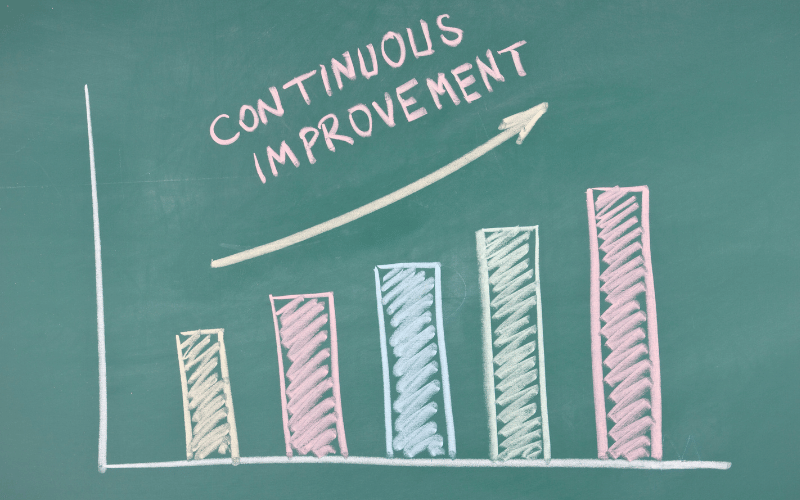Are you a CTO or a founder of a SME navigating the complexities of software development? Have you ever wondered how to enhance your development team’s efficiency and adaptability in this growing tech world? If so, you’re in the right place.
In the realm of software development, the concepts of Agile and continuous improvement are pivotal.
What is Continuous improvement within Agile frameworks?
Continuous improvement within Agile frameworks is about constantly seeking ways to enhance processes, products, and services. It’s a philosophy that encourages iterative development, where teams continuously refine and optimize their work.
Agile methodologies, by their very nature, are built on an iterative and adaptable foundation. This creates a perfect synergy where continuous improvement becomes an ingrained part of the development process, not a separate activity.
Agile practices like short sprints, constant feedback loops, and a focus on customer value provide the ideal platform for continuous learning, adaptation, and improvement.
In this blog, we’ll delve deeper into the principles of continuous improvement in Agile, explore key tools and techniques, discuss the benefits and challenges, and provide insights on building a culture of continuous improvement within your organization.
Principles of Continuous Improvement in Agile
We’ve established that Agile methodologies provide the perfect breeding ground for continuous improvement. But how exactly does it work in practice? Here are some core principles that underpin continuous improvement within Agile:
- Early and Continuous Delivery: Break down projects into bite-sized chunks. This Agile approach allows you to get your product in front of users early and often. Their feedback becomes your guide, ensuring what you’re building stays relevant and delivers value right from the start.
- Focus on Customer Needs and Feedback: Constant communication is key in Agile. By actively soliciting and integrating customer feedback throughout the development cycle, you guarantee the final product aligns perfectly with what your clients truly need.
- Individuals and Interactions Over Tools: Agile recognizes the importance of a skilled and empowered team. Collaboration, open communication, and a focus on fostering individual strengths lead to better problem-solving and innovation.
- Responding to Change Over Following a Plan: The market and customer needs are dynamic. Agile embraces flexibility, allowing you to adapt to changes quickly and integrate new features or functionalities seamlessly.
- Experimentation and Learning: Don’t be afraid to try new things! Agile encourages experimentation, learning from both successes and failures. This approach fosters a culture of innovation and continuous improvement.
- Simplicity and Working Solutions: Agile prioritizes delivering a functional product over an overly complex one. This ensures faster development cycles and allows you to focus on features that truly matter to your customers – features that will deliver real value.
By embracing these principles, you create a foundation for continuous improvement within your Agile development process.
Key Agile Continuous Improvement Tools and Techniques
So, you’re convinced about the power of continuous improvement within Agile.
Now you might be wondering, “What tools can I use to make this happen?” Here are some powerful tools and techniques that seamlessly integrate with your Agile workflow to enhance continuous improvement:
- Lean Manufacturing and its Application in Agile
- Beyond Minimizing Waste: While minimizing waste remains core to Lean, modern interpretations emphasize “value creation” alongside waste reduction. This ensures your Agile development process focuses on activities that deliver genuine value to your customers.
- Focus on Value Streams: Lean principles encourage mapping value streams to identify all steps involved in delivering a product or service. This holistic view helps pinpoint areas for waste elimination and process optimization within your Agile workflow.
- Just-in-Time (JIT) Inventory Management: Agile and Lean share the concept of JIT, focusing on delivering features “just in time” to meet customer needs. This reduces development overhead and ensures you’re building features that truly resonate with your users.
Not sure how to apply Lean principles to your Agile workflow? Let Codewave guide you through optimizing your processes for maximum value creation.
- Plan-Do-Check-Act (PDCA) Cycle
- Modern PDCA Variations: The classic PDCA cycle has evolved into numerous variations, each catering to specific needs. Some popular variations include the Shewhart Cycle (focusing on statistical control) and the Deming Cycle (emphasizing continuous improvement). Choose the PDCA variation that best aligns with your specific Agile improvement goals.
- Data-Driven Decision Making: The “Check” phase of the PDCA cycle is crucial. Modern Agile practices leverage data analytics tools to gather and analyze data related to development processes and product performance. This data-driven approach ensures informed decisions during the “Act” phase, leading to more effective improvements.
- Kanban Boards
- Digital Kanban Boards: Traditional physical Kanban boards are still valuable. However, digital Kanban boards offer enhanced features like real-time collaboration, work in progress (WIP) limits, and automated workflow notifications. These features improve transparency, streamline communication, and facilitate better process optimization within your Agile teams.
- Kanban Maturity Model: The Kanban Maturity Model is a framework that helps Agile teams assess their Kanban board usage and identify areas for improvement. This model guides teams towards a more mature and effective Kanban implementation, leading to enhanced workflow efficiency.
- The role of Retrospectives
- Psychological Safety: Modern Agile emphasizes psychological safety during retrospectives. This means creating a safe space where team members feel comfortable sharing honest feedback and concerns without fear of judgment. Psychological safety fosters open communication and leads to more productive retrospectives.
- Focus on Learning: Effective retrospectives go beyond simply identifying problems. Modern Agile practices encourage teams to focus on learning opportunities. By asking “What can we learn from this?” teams can transform setbacks into valuable learning experiences that fuel continuous improvement.
- Root Cause Analysis (5 Whys)
Beyond 5 Whys: While the 5 Whys technique is a powerful tool, it’s not always exhaustive. Modern Agile practices encourage combining the 5 Whys with other root cause analysis techniques like the Fishbone Diagram (Ishikawa Diagram) to gain a more comprehensive understanding of complex problems.
- Total Quality Management (TQM)
- Customer Centricity: Modern TQM interpretations place even greater emphasis on customer centricity. By integrating Voice of the Customer (VOC) data into Agile development processes, teams can ensure they’re continuously improving features and functionalities that truly matter to their customers.
- Continuous Improvement Culture: Agile and TQM share a common philosophy – a relentless pursuit of continuous improvement. By integrating TQM principles, Agile teams can cultivate a culture where improvement is not just a goal, but a core value woven into the fabric of the development process.
Benefits of Continuous Improvement in Agile
Having a toolbox stocked with the right equipment is essential, but what are the actual benefits of wielding these tools for continuous improvement within Agile? Let’s explore the positive impact this approach can have on your software development process:
Enhanced Operational Efficiency and Productivity
By continuously identifying and eliminating waste, streamlining workflows, and optimizing resource allocation, Agile with continuous improvement helps your team work smarter, not harder. This translates to faster development cycles, improved resource utilization, and ultimately, increased productivity.
Imagine a scenario where your development team frequently encounters bottlenecks in the coding phase. Through continuous improvement practices, you might identify a need for additional code reviews or pair programming sessions. This proactive approach can significantly improve coding efficiency and eliminate these bottlenecks over time.
Increased Employee Engagement and Teamwork
A key principle of continuous improvement is fostering a culture of open communication and collaboration. Regular retrospectives and a focus on learning from both successes and failures empower your team members to actively participate in the improvement process. This sense of ownership and involvement leads to increased employee engagement and stronger team dynamics.
A highly engaged team is a motivated team. When team members feel their voice is heard and their ideas are valued, they’re more likely to go the extra mile and contribute their best work. This collaborative spirit fostered by continuous improvement can significantly benefit your overall project outcomes.
Reduction of Waste and Optimization of Resources
Agile and continuous improvement go hand-in-hand in eliminating waste from your development process. This waste can take many forms, such as rework due to errors, time spent on unnecessary features, or inefficient communication channels. By identifying and eliminating these forms of waste, you optimize your resource allocation and ensure your team is focused on activities that deliver real value.
Think about all the time and effort wasted in fixing bugs that could have been prevented through proper code reviews. Continuous improvement encourages proactive measures like code reviews and unit testing, which can significantly reduce rework and optimize your development resources.
Continuous Learning and Innovation
The Agile methodology thrives on a culture of experimentation and learning. Continuous improvement takes this a step further by actively seeking opportunities to learn from both successes and failures. This growth mindset fosters a culture of innovation, where your team is constantly seeking new ways to improve processes, develop features, and deliver value to your customers.
By constantly analyzing your development process and learning from past experiences, your team can identify areas for improvement and implement innovative solutions. This continuous learning cycle keeps your development process at the forefront and your product offering ahead of the competition.
Improved Customer Satisfaction and Value Delivery
At the end of the day, the ultimate goal is to deliver a product or service that exceeds customer expectations. Continuous improvement within Agile ensures you’re constantly gathering customer feedback, identifying their needs, and adapting your development process accordingly. This focus on customer centricity leads to higher customer satisfaction and ensures you’re delivering features and functionalities that truly resonate with your target audience.
Imagine a situation where you release a new feature based on initial assumptions about customer needs. Through continuous improvement practices, you might gather user feedback indicating the feature is complex and not well-received. This valuable insight allows you to course-correct, refine the feature, or even remove it altogether, ultimately leading to a more customer-centric product.
By implementing these principles and leveraging the tools and techniques discussed previously, you can create a powerful Agile environment driven by continuous improvement. This, in turn, will lead to a more efficient, innovative, and customer-centric development process, giving your SME a significant competitive edge in the ever-evolving software development landscape.
Experience these benefits firsthand by partnering with Codewave, where continuous improvement is not just a goal, but a cornerstone of our project management tools and methodologies.
Read: Why Choose Bespoke Software Development Services Over Ready-Made Solutions
Building a Culture of Continuous Improvement
So, you’re convinced about the merits of continuous improvement within Agile, and you’re equipped with a toolbox full of powerful tools and techniques. Here are some key strategies to cultivate a culture where continuous improvement becomes ingrained in your Agile development process.
Mapping Value Streams
The first step is to gain a clear understanding of your current development process. Value stream mapping helps visualize all the steps involved in delivering a product or service to your customer.
By identifying bottlenecks, areas of waste, and handoff points, you can pinpoint areas for improvement and prioritize your efforts.
Encouraging Cross-Functional Collaboration
Continuous improvement thrives on open communication and collaboration across different functions within your team. Break down silos between developers, designers, testers, and product managers.
Encourage knowledge sharing, joint problem-solving sessions, and cross-functional participation in retrospectives. This fosters a collective ownership of the development solution and a shared responsibility for continuous improvement.
Measuring and Tracking Relevant Performance Metrics
Data is your friend when it comes to continuous improvement. Identify key performance indicators (KPIs) that align with your improvement goals. These might include metrics like development cycle time, defect rates, customer satisfaction scores, or employee engagement surveys.
Regularly track these metrics to measure progress and identify areas where your continuous improvement efforts are paying off.
Planning and Conducting Frequent Experiments
Continuous improvement thrives on a willingness to experiment and learn from both successes and failures. Encourage your team to propose new ideas, pilot innovative approaches, and experiment with different tools and techniques.
Create a safe space for experimentation where failures are viewed as learning opportunities, not setbacks.
Creating a Safe Environment Where Feedback is Valued
Psychological safety is paramount for a thriving culture of continuous improvement. Team members must feel comfortable sharing honest feedback, suggesting changes, and admitting mistakes without fear of judgment. Foster a culture of open communication, active listening, and appreciation for diverse perspectives.
Celebrating Successes and Acknowledging Contributions
Recognition and appreciation go a long way in motivating your team and sustaining a culture of continuous improvement. Celebrate milestones achieved, acknowledge individual and team contributions, and share success stories to keep your team motivated and engaged in the ongoing improvement journey.
Challenges and Solutions in Agile Continuous Improvement
While the potential benefits of continuous improvement within Agile are significant, there are also challenges to consider. Here are some common roadblocks you might encounter and strategies to overcome them:
- Resistance to Change: People are often creatures of habit, and adapting to new ways of working can be met with resistance. Address this by clearly communicating the benefits of continuous improvement and involving your team in the process. Encourage open discussions, address concerns, and highlight how continuous improvement can empower them to work smarter and achieve better results.
- Lack of Leadership Support: For continuous improvement to take root, it needs buy-in from leadership. Leaders must champion the initiative, allocate necessary resources, and remove roadblocks that hinder progress. If leadership support is lacking, focus on building a strong business case for continuous improvement. Present data and evidence showcasing the potential benefits for team efficiency, product quality, and overall business success.
- Competing Priorities and Short-Term Focus: Agile teams often operate under tight deadlines and face constant pressure to deliver. This can make it difficult to carve out time for continuous improvement activities. Address this by integrating improvement initiatives into your existing Agile workflow. Allocate dedicated time slots within sprints for retrospectives and improvement discussions. Frame continuous improvement as a way to optimize workflows and ultimately deliver results faster and more efficiently.
- Data Overload and Analysis Paralysis: The abundance of data available in modern software development can be overwhelming. Focus on identifying and tracking a few key metrics that directly align with your improvement goals. Invest in user-friendly data visualization tools to make data analysis easier and more accessible for your team.
- Lack of Focus and Unrealistic Goals: Continuous improvement is a marathon, not a sprint. Trying to tackle too many things at once can lead to scattered efforts and a lack of progress. Set clear, achievable goals for each improvement cycle and prioritize initiatives that will have the most significant impact on your development process.
Read: Comparing Design Thinking and Agile: Exploring Differences and Similarities
Conclusion
Kudos for making it this far!
The journey of continuous improvement within Agile is an ongoing cycle. There will be successes to celebrate, challenges to overcome, and new learnings to integrate.
However, the rewards are substantial. By adopting the principles and practices outlined in this blog, you can create a dynamic and responsive development environment that thrives on innovation, adaptation, and a relentless pursuit of excellence.
Here are some final takeaways to keep in mind:
- Continuous improvement is a cultural shift, not just a process. Building a culture that values learning, experimentation, and open communication is key to long-term success.
- Focus on small, incremental improvements. Don’t try to overhaul your entire development process overnight. Start small, track your progress, and celebrate wins along the way.
- Continuous improvement is an investment, not a cost. The time and resources dedicated to improvement will pay off in the form of increased efficiency, higher quality products, and a more engaged and productive workforce.
- Embrace the learning journey. Continuous improvement is a continuous learning process. Be open to new ideas, experiment with different approaches, and learn from both successes and failures.
Ready to take your Agile development to the next level and unlock the power of continuous improvement?
Codewave can help! We offer a comprehensive suite of Agile project management tools designed to streamline your workflow, boost team collaboration, and empower continuous improvement throughout the development lifecycle.
Visit our website today to learn more about how Codewave can help your Agile team achieve excellence!
Read: What is Software Development Consulting Services and its Process
Codewave is a design thinking led digital transformation company enabling organisations with playful innovation using AI & ML, IoT & Edge, AR, VR, Cloud, Blockchain, and Data.







